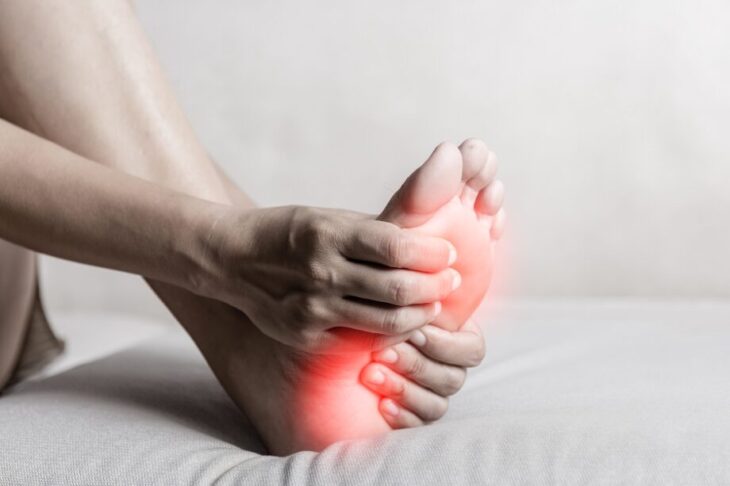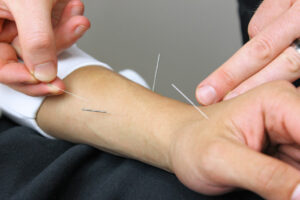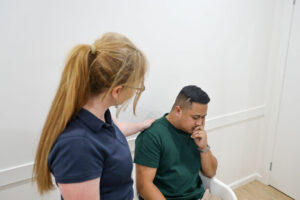Quick Summary
Plantar fasciitis causes heel and arch pain due to inflammation of the plantar fascia. Managing it requires a holistic approach, including stretching, trigger point therapy, proper footwear, and lifestyle changes. Techniques like calf stretches, foot rolling with a trigger point ball, and strengthening exercises can help relieve pain and improve flexibility.
Diet, hydration, weight management, and ergonomic practices also play a key role in recovery.
Plantar fasciitis is a common condition that affects millions worldwide, leading to sharp, persistent pain in the heel and arch of the foot. Characterised by inflammation of the plantar fascia, the thick band of tissue that runs across the bottom of your foot, this condition can make everyday activities challenging.
At Evolution Medical Care, we understand the importance of empowering our patients with science-backed self-care strategies. In this article, we will guide you through effective stretches and the use of trigger point balls to manage and alleviate the discomfort of plantar fasciitis yourself.
Understanding Plantar Fasciitis
Plantar fasciitis is typically recognised by a stabbing pain that usually occurs with your first steps in the morning. As you move more, the pain normally decreases; however, it might return after long periods of standing, or when you stand up after sitting. The condition is a result of strain and inflammation of the plantar fascia which is a structure that connects the forefoot to the hindfoot and stabilises the arch of our foot. When the plantar fascia is inflamed, it leads to discomfort that can be debilitating.
The Science of Plantar Fasciitis
When the plantar fascia is strained, it triggers an inflammatory response. Cytokines, a type of protein involved in cell signalling, flood the area, initiating inflammation to repair the damaged tissue. This process is natural and necessary, but when it becomes chronic, it leads to persistent pain. Moreover, this inflammation can affect the surrounding nerves, leading to an increased pain response, also affecting overall blood flow in the foot.
The nervous system plays a crucial role in the sensation of pain. In plantar fasciitis, the persistent inflammation can stimulate the nerves in the foot, leading to a continuous pain signal being sent to the brain. This is exacerbated by reduced blood flow to the inflamed area, which is necessary for healing and nutrient delivery. Enhancing blood flow can thus be a key factor in managing plantar fasciitis symptoms.

Self-Directed Stretching Techniques
Importance of Self-Care for Plantar Fasciitis
Engaging in self-care through stretching is essential for those suffering from plantar fasciitis. Regularly stretching the plantar fascia and Achilles tendon can increase flexibility, improve blood flow, and reduce the tension that contributes to plantar fasciitis pain.
Effective Stretches for Plantar Fasciitis Relief
For individuals coping with plantar fasciitis, certain stretches can provide significant relief:
Calf Stretches: Tight calf muscles can place additional strain on your plantar fascia, exacerbating pain. Performing calf stretches can help alleviate this tension. Here’s how:
- Stand arm’s length from a wall.
- Place your right foot behind your left.
- Slowly bend your left leg forward, keeping your right knee straight and your right heel on the ground.
- Hold the stretch for 15-30 seconds and release. Repeat three times for each leg.
Plantar Fascia Stretch: Directly stretching the plantar fascia can help to relieve pain and increase flexibility. Try this simple stretch:
- Sit down and cross one foot over your opposite knee.
- Grab the base of your toes and pull them towards your shin, creating a gentle stretch along your arch and the bottom of your foot.
- Hold this position for 15-30 seconds and repeat three times for each foot.
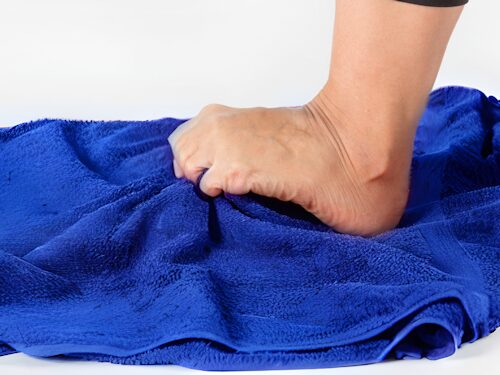
Towel Curls: This exercise helps strengthen the muscles on the bottom of your feet.
- While seated in a chair, place a small towel on the floor directly in front of you.
- Place your feet flat over the towel.
- Using your toes, scrunch the towel towards you, then push it away. Repeat 10-15 times.
Marble Pickup: This exercise is excellent for strengthening the muscles in your feet.
- Place 20 marbles on the floor.
- Using your toes, pick up one marble at a time and place it in a bowl. Repeat until you have moved all the marbles.
Trigger Point Therapy at Home
Trigger points are tiny knots that develop in muscles, causing pain. In the case of plantar fasciitis, these can form in the arch of the foot and contribute to heel pain.
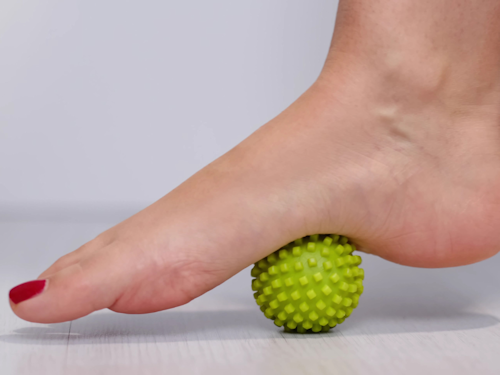
DIY Techniques with Trigger Point Balls
- Trigger Point Ball Selection: Using a firm ball, can help to target these knots effectively.
- Techniques for Use: Rolling the foot over the ball can apply targeted pressure to alleviate tightness.
The Biochemical Response to Trigger Point Therapy
- Endorphin Release: Applying pressure to trigger points can encourage the release of endorphins, our body’s natural painkillers.
- Restoration of Homeostasis: Regular trigger point therapy can help to restore balance in the muscle tissues, aiding in the return to a state of homeostasis.
Lifestyle Adjustments for Enhanced Recovery
Holistic Self-Care Strategies
When tackling the discomfort of plantar fasciitis, it’s important to look beyond the immediate symptoms and consider broader lifestyle changes that can support long-term recovery and overall well-being.
- Ergonomic Practices: The way we position our bodies during work and leisure activities can have a profound impact on our foot health. An ergonomic assessment can help identify and correct postures or arrangements that put undue stress on the feet. For example, ensuring that your work chair and desk are at the proper height can prevent compensatory postures that strain your feet. Ergonomic floor mats can also provide cushioning and support if you’re required to stand for long periods.
- Mindfulness and Stress Reduction: Chronic stress can have a tangible effect on physical health, including the exacerbation of plantar fasciitis symptoms. Techniques like mindfulness meditation, deep-breathing exercises, and yoga can reduce stress levels, which may in turn lower inflammation and pain. By directing attention to the present moment and practicing relaxation, we can initiate a ‘relaxation response’ in the body, counteracting the stress response that often aggravates inflammation.

Nutritional and Lifestyle Tips
Nutrition and daily habits are cornerstones of a holistic approach to health. They are particularly important when managing a condition like plantar fasciitis.
- Anti-inflammatory Foods: Diet plays a key role in inflammation levels in the body. Integrating foods high in omega-3 fatty acids—such as salmon, chia seeds, and walnuts—and antioxidants—like blueberries, spinach, and dark chocolate—can contribute to reduced inflammation. Additionally, spices such as turmeric, which contains curcumin, have been shown to have potent anti-inflammatory properties.
- Hydration: Water is essential for life and the body’s healing processes. It aids in the transportation of nutrients and the elimination of waste products from the cells. Adequate hydration ensures that the tissues in the foot are well-nourished and capable of repair, and it can also help maintain the elasticity of the plantar fascia.
- Footwear Choices: The right shoes can make a significant difference in managing plantar fasciitis. Features to look for include:
Arch Support: Good arch support can distribute pressure more evenly.
Cushioned Sole: This can absorb impact and relieve pressure on the heel.
Roomy Toe Box: Prevents compression that can exacerbate pain. - Weight Management: Excess body weight can increase the strain on your plantar fascia. A balanced diet and regular exercise can aid in weight management, subsequently reducing the stress on your feet. Low-impact activities such as swimming or cycling can be beneficial.
- Exercise Regularly: Engaging in regular physical activity that strengthens the muscles in the feet and legs can help support the plantar fascia. However, it’s important to choose exercises that do not put additional strain on the feet.
- Rest and Recovery: Adequate rest is crucial for healing. Ensure you’re not overworking your feet and give them time to recover, especially after activities that put strain on the plantar fascia.

By embracing these holistic self-care strategies and lifestyle adjustments, you can create an environment conducive to recovery and long-term foot health. Remember, small changes can make a big difference in managing plantar fasciitis and enhancing your quality of life.
Conclusion and Encouragement for Self-Management
In conclusion, managing plantar fasciitis effectively requires a comprehensive approach that includes self-directed stretches, trigger point therapy, complementary self-care modalities, and holistic lifestyle changes. By understanding the underlying biochemistry and integrating these science-based practices, you can take proactive steps towards alleviating pain and enhancing your foot health.
Remember, while self-care is powerful, seeking professional advice is invaluable for a condition like plantar fasciitis. At Evolution Medical Care, our team is dedicated to providing personalised, research-backed care to support you on your journey to recovery.
We invite you to reach out to us to discuss how we can assist you further. Whether through additional guidance on self-care strategies or through our range of treatments, we are here to help. Take the first step towards healing by booking an appointment online or giving us a call at (02) 4709 6727. Your health is our priority, and we look forward to being a part of your healing process.

